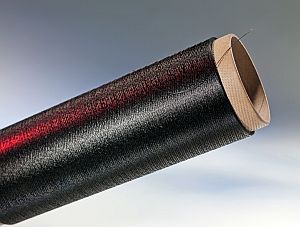SGL CARBON
Launching carbon fibre yarn production in Scotland
 “Sigrafil C SBY 70” stretch-broken carbon fibre yarn (Photo: SGL Group) |
Germany’s SGL Group (Wiesbaden; www.sglgroup.com) has started producing stretch-broken carbon fibre yarn in Scotland’s Muir of Ord. The site was officially inaugurated on 7 November 2013. “We are expanding our existing value chain by developing new textile procedures and refining our Sigrafil C carbon fibre into a fine yarn,” said Andreas Wöginger, of product and technology management SGL Group.
The high-performance yarn, marketed under the brand name "Sigrafil C SBY", is a proprietary SGL Group development. The company says that aside from typical carbon fibre characteristics like high strength, light weight and temperature resistance, the material also exhibits excellent knot and loop strength. Due to its electrical resistance, the yarn can be used as a heat conductor, but can also function as sewing or knitting yarn for applications where carbon fibre composite parts are exposed to high service stresses, including in the automotive industry.
The precursor used for the manufacture of fibre products is sourced, among others, from SGL Carbon subsidiary Fibras Sintéticas de Portugal (Fisipe, Lavradio / Portugal; www.fisipe.pt), which the German group acquired last year – see Plasteurope.com of 02.04.2012. SGL also produces multi-filament carbon fibres of the “Sigrafil C” family in Muir of Ord. The latter is offered either as continuous filament or as short strands, as well as in the form of a thermally stable, non-burnable textile fibre (“Panox”). The group employs 189 workers at the Scottish site.
The high-performance yarn, marketed under the brand name "Sigrafil C SBY", is a proprietary SGL Group development. The company says that aside from typical carbon fibre characteristics like high strength, light weight and temperature resistance, the material also exhibits excellent knot and loop strength. Due to its electrical resistance, the yarn can be used as a heat conductor, but can also function as sewing or knitting yarn for applications where carbon fibre composite parts are exposed to high service stresses, including in the automotive industry.
The precursor used for the manufacture of fibre products is sourced, among others, from SGL Carbon subsidiary Fibras Sintéticas de Portugal (Fisipe, Lavradio / Portugal; www.fisipe.pt), which the German group acquired last year – see Plasteurope.com of 02.04.2012. SGL also produces multi-filament carbon fibres of the “Sigrafil C” family in Muir of Ord. The latter is offered either as continuous filament or as short strands, as well as in the form of a thermally stable, non-burnable textile fibre (“Panox”). The group employs 189 workers at the Scottish site.
25.11.2013 Plasteurope.com [226881-0]
Published on 25.11.2013

 German version of this article...
German version of this article...